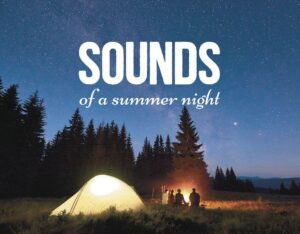All organisms communicate…just imagine what they would say to us if we only took the time and energy to listen. Nature is beautiful, embrace it and enjoy listening to the sounds of summer nights.
Source: The Mountaineer
Go out on a warm, humid summer night, and you’ll hear the sounds of nature coming from the treetops, bushes, and grasses. Curiosity can be satisfied by simply stopping, relaxing, and enjoying the chorus as beautiful music for a summer evening…but as I’m sure many of us wonder, who is making these noises? 
Katydids and crickets seem to be the loudest members during the summer months. They both achieve sound by rubbing their forewings together rapidly. The upper wing has a series of serrated teeth called a file, and the lower wing is like a scraper.
Females want the healthiest males in order to produce the best offspring. Therefore, they judge the fitness of the male by the sound they create — the louder and more confident the trill, the greater the fitness of the male.
Katydids are well-camouflaged insects, usually green, and shaped like a simple leaf. During the day, they appear to be either dead or simply a leaf on a plant.
Crickets look more like grasshoppers and are smaller than katydids. Folklore holds many stories about them in various cultures. Sometimes they are seen as a sign of impending rain or a financial windfall. Crickets are known as symbols of happiness, longevity, and good health.
Cicadas are often confused with katydids and crickets. Although they are usually more active during the daylight hours, they can be heard at various times of day or night in some locations.
They make repeated courtship calls by rapidly vibrating thin membranes and ribs, which echo in a hollow belly, like a sound box. Most cicadas go through a two to five year cycle, spending most of their life as an underground nymph. The periodic cicadas emerge at intervals of 10 to 17 years. Cicadas have the reputation of being the loudest inset in the world; their buzzing can be insufferable.
Frogs also tend to be renowned members of an evening serenade. They are usually heard close to dusk and early morning when they are breeding. Frogs create their sound by pushing air from the lungs into an expanding pouch in the throat. Then they force the air back down into their lungs over vocal cords. The deep-throated croak of a bullfrog is occasionally interjected into the chorus, like a bass drum.
Owls often eject a hoot or two in the background of the orchestra. Their unique features include stationary eyes with binocular vision; binaural hearing recording sounds on both sides, like headphones using two separate channels from two separate microphones; sharp talons; and feathers adapted for silent flight.
The barred owl has a distinctive call and during courtship, mated pairs perform a riotous duet of cackles, hoots, caws, and gurgles. They are common above 3,500 feet in elevation and can sometimes be heard during the day.
The small eastern screech owl is frequently found below 4,000 feet from July to October. Its quavering, descending call sounds similar to the neighing of a horse. It has two distinctly different color phases. In the south, it is usually a reddish brown color. It can be gray in the north. It has short ear-looking tufts and yellow eyes.
The smallest owl in eastern North America is the northern saw-whet, commonly seen in the spruce-fir forests above 5,000 feet. The monotonous, constant song of “whot-whot-whot…” can be heard on clear, windless nights.
At dusk, whip-poor-wills begin pronouncing their name for several hours into the night then sing again at dawn. They can be heard below 3,000 feet near the edges of open fields where they enjoy their favorite insects. Mockingbirds can also interrupt the night with their constant, mimicking tweets. Sometimes they are joined by field sparrows and yellow-breasted chats.
All organisms communicate…just imagine what they would say to us if we only took the time and energy to listen. Nature is beautiful, embrace it and enjoy listening to the sounds of summer nights.
Source: The Mountaineer